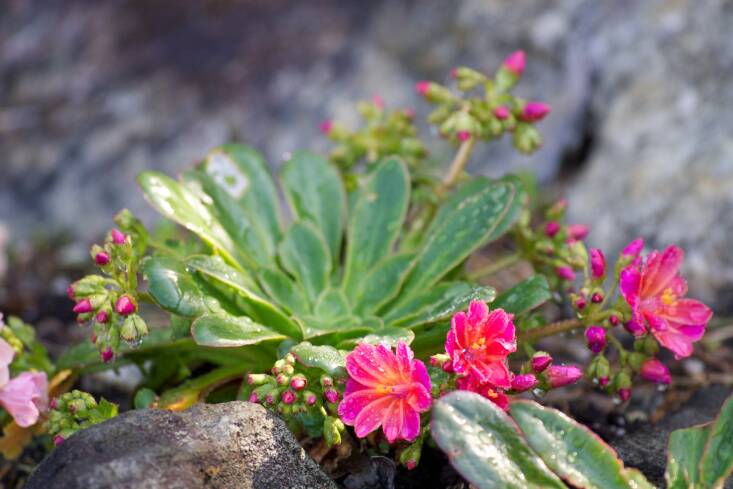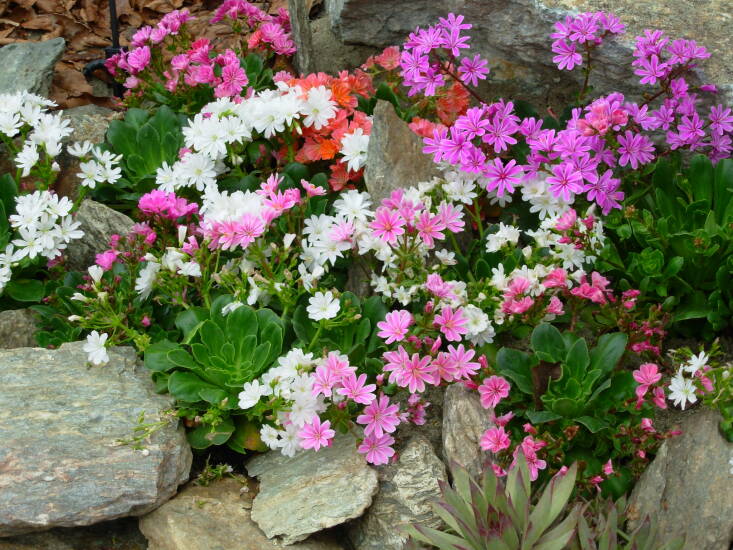Cliff Maids, Lewisia cotyledon
Meet my new plant crush, Lewisia. Interestingly, it wasn’t love at first sight. I’d glazed over this evergreen perennial at garden stores probably a million times because it wasn’t flowering, and my thoughts were always, I have no real interest in this tiny, fleshy thing. But had I first seen it in bloom in a garden, reaching its full potential and not stunted in a constricting four-inch container, then I would have definitely been an early groupie. Also, I’m fairly certain I wasn’t aware this was a California native. Because if I had known, then I would’ve been like, I love plants that are California native, like me.
Here’s why I’m a Lewisia convert.

Let’s start with the accolades. Lewisia (also known as cliff maids) won the prestigious Award of Garden Merit of the Royal Horticultural Society. Not too shabby. It’s easy to see why it garnered attention. This low-maintenance evergreen perennial grows into an impressive rosette of succulent-like dark green fleshy leaves that are shaped like long spoons. But as I mentioned, it’s not the foliage that led to my change of heart. The eye-catching feature are the sprays of the most charming funnel-shaped flowers. Opening to about one inch across on sturdy six-inch stems, the flowers start their show in the late spring and continue through summer, or later if happy. Ranging from pale pink, yellow, to white, salmon or magenta, the delicate petals beg for a closer inspection of its polite detailing and artistic shading between hues.

Hailing from Southern Oregon and Northern California, this sweet but hardy plant is named after the explorer Meriwether Lewis, who first discovered its close relative Lewisia redevia while on the famed Lewis and Clark Expedition. Quite small and reaching only 8 to 10 inches tall, this plant eventually grows into a surprisingly charming bouquet that’s found on rocky cliffs in high elevations. Its strong root structure and deep tap root helps it cling to a rugged terrain. You can help this plant thrive in your garden by trying to recreate its natural environment. This means planting it in very fast draining soil and preferably grown sideways, tucked into a rocky wall so that any excess water will drain away from the crown.
Related: My crafty husband built a green roof for our little free library. I filled the “planter” with fast draining succulent soil and added a six-pack of Lewisia. Because of the pitch of the roof, these cuties ended up being planted on an angle, like their native habitat. I also added some Sedum ‘Blue Spruce’ and ‘Cape Blanco’ to the mix. After a few days, the Lewisia started blooming like crazy, beckoning and welcoming curious readers to the library.
Cheat Sheet

- So lovely and looking right at home in rock gardens, crevice gardens, green roofs, and containers.
- Understandably attracts butterflies and other pollinators.
- Cut the flowers and add to tiny flower arrangements.
- Great companion plants include: Campanulas, Sedums, and fellow California native Dudleyas
Keep It Alive

- Plant these cuties in full sun near the coast or part sun inland where summers are hot.
- Prefers slightly acidic sandy soil that is very well-draining. I have mine planted in succulent soil.
- Plant them high in the soil to keep the crown dry.
- Lewisia is not a thirsty plant and is drought tolerant once established. Protect from overly wet winters if possible.
- Appreciates a top dressing of granite to simulate its native rocky home.
- Prune away spent flowers to prolong blooming.
See also:
- The Garden Decoder: What Is ‘Crevice Gardening’?
- Flavorful and Fragrant: 5 Top Drought-Tolerant Herbs to Plant Now
- Gardening 101: Dudleya Succulents
Frequently asked questions
What is Lewisia cotyledon?
Lewisia cotyledon, also known as Cliff Maids, is a perennial plant native to western North America. It belongs to the Portulacaceae family and is loved for its showy flowers and succulent leaves.
How tall does Lewisia cotyledon grow?
Lewisia cotyledon typically grows up to 6-8 inches in height. However, the exact height may vary depending on the specific variety and growing conditions.
What are the flower colors available in Lewisia cotyledon?
Lewisia cotyledon flowers come in a wide range of colors, including shades of pink, orange, red, yellow, and white. Some varieties may have bicolored or striped petals as well.
How do I care for Lewisia cotyledon plants?
Lewisia cotyledon thrives in well-draining soil and prefers full sun or partial shade. It requires regular watering, especially during dry periods. Additionally, it is important to protect the plant from excessive moisture to prevent root rot. Fertilize the plant with a balanced, organic fertilizer once or twice a year.
Can Lewisia cotyledon be grown in containers?
Yes, Lewisia cotyledon can be successfully grown in containers. Ensure that the container has proper drainage holes to prevent waterlogging. Use a well-draining potting mix and provide regular watering and sunlight as per the plant's requirements.
When does Lewisia cotyledon bloom?
Lewisia cotyledon typically blooms from late spring to early summer. The exact blooming period may vary depending on the specific variety and climatic conditions. Deadhead the spent flowers to encourage prolonged blooming.
Is Lewisia cotyledon deer-resistant?
Yes, Lewisia cotyledon is considered deer-resistant. Deer generally avoid feeding on this plant due to its succulent leaves and bitter taste. However, it's important to note that deer preferences can vary, so it's best to observe your specific deer population in case of any exceptions.
How do I propagate Lewisia cotyledon?
Lewisia cotyledon can be propagated by seed or division. To propagate through seeds, collect the ripe seeds and sow them in well-draining soil. Keep the soil consistently moist until germination. Division can be done by carefully separating the rooted clumps and replanting them in desired locations.
Are Lewisia cotyledon plants drought-tolerant?
Lewisia cotyledon is fairly drought-tolerant once established. However, during extended periods of drought, it is recommended to provide regular watering to maintain optimal growth and flowering.
Can Lewisia cotyledon withstand cold temperatures?
Lewisia cotyledon is generally hardy and can withstand cold temperatures, especially in USDA hardiness zones 4-8. However, it's important to provide sufficient winter protection, such as mulching, in colder regions to prevent frost damage.








Have a Question or Comment About This Post?
Join the conversation